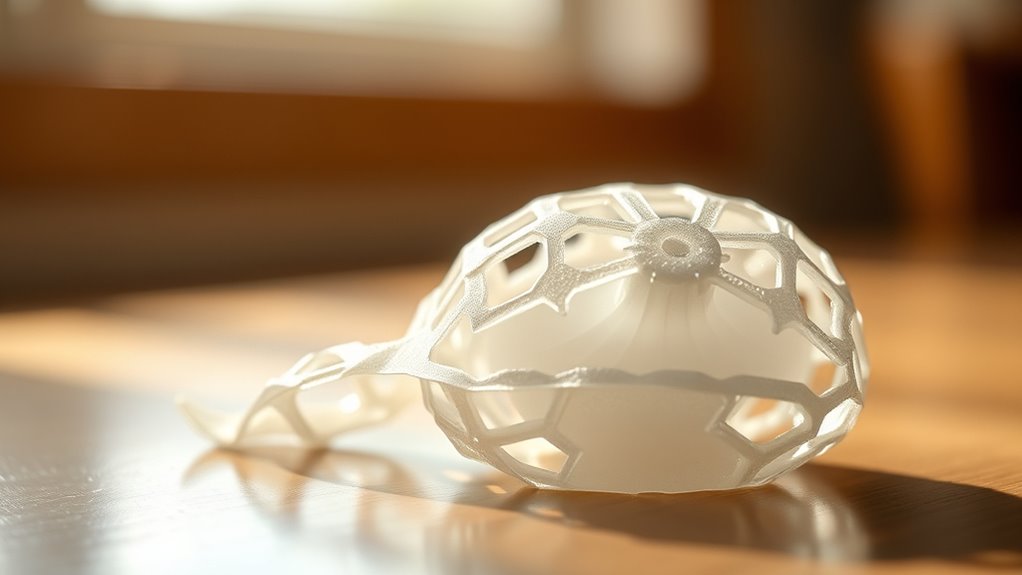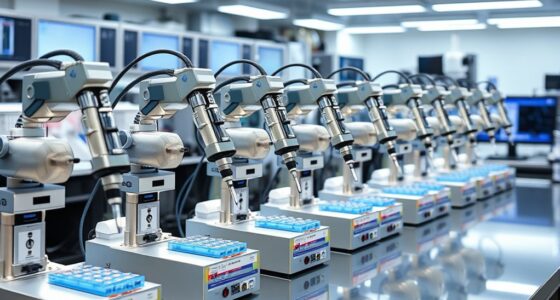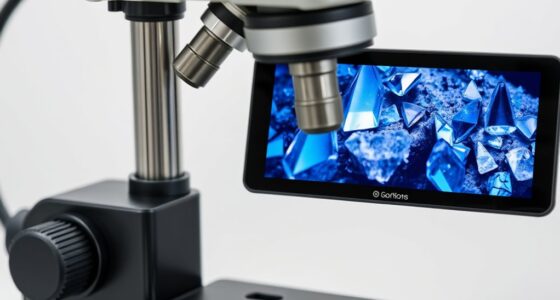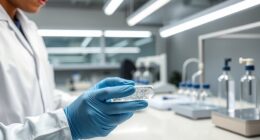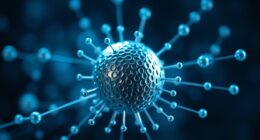If you’re searching for the best resin 3D printers in 2025 to achieve unmatched detail and precision, I recommend models that feature high-resolution capabilities like 8K LCD prints, along with specialty resins that offer excellent surface finish, durability, and ease of use. Resins such as Inslogic 14K, Phrozen Aqua-Gray 8K, and ABS-like formulations deliver remarkable accuracy for intricate miniatures, prototypes, and functional parts. Keep exploring, and you’ll discover key tips to choose the ideal setup for your projects.
Key Takeaways
- The top resin 3D printers in 2025 feature high-resolution capabilities, such as 8K LCD screens, ensuring unmatched detail and precision.
- Advanced resins with low shrinkage, high optical resolution, and smooth flow contribute to highly accurate and detailed prints.
- Ease of use, safety features, and post-processing support make these printers suitable for both professional and hobbyist applications.
- Compatibility with various resin types and workflow flexibility allows for precise artistic, prototyping, and functional parts.
- Optimized print speed, small layer heights, and efficient curing methods enhance accuracy and overall print quality.
Inslogic 14K 3D Printer Resin for Miniatures (Gray, 1kg)
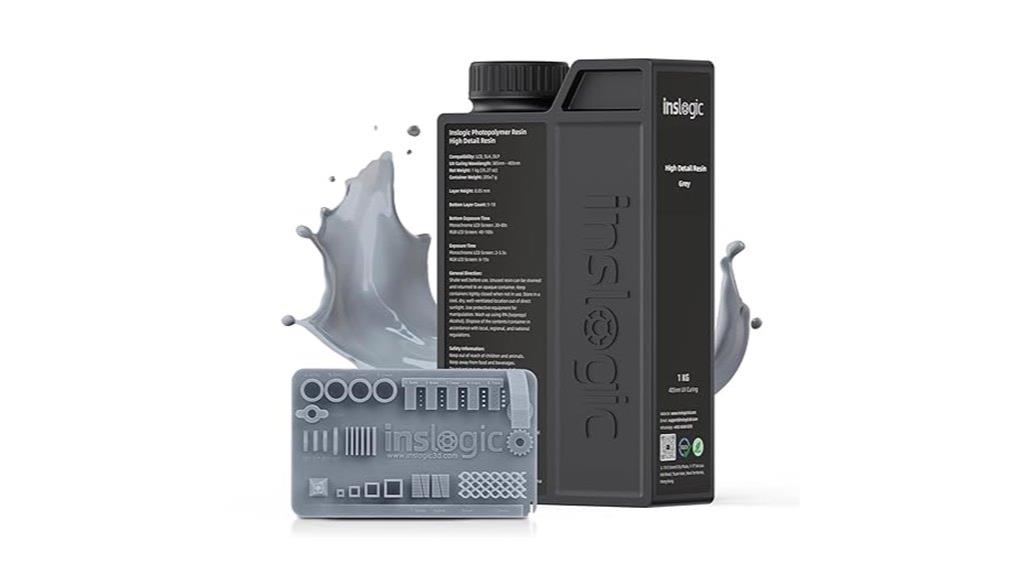
If you’re looking for a resin that delivers exceptional detail for miniature printing, the Inslogic 14K 3D Printer Resin is an excellent choice. I’ve found it’s perfect for capturing intricate designs and high-resolution prototypes, thanks to its compatibility with 8K+ printers. The resin produces smooth, matte surfaces that are ideal for painting and finishing. Its low shrinkage minimizes cracking and warping, ensuring durability and stability. Plus, its eco-friendly, low-odor formulation makes the printing process safer and more comfortable. Packaged securely in leak-proof bottles, it’s easy to store and dispense. Support from Inslogic’s team is reliable, making it a seamless experience.
Best For: hobbyists and professionals seeking high-precision miniature prints with fine details and smooth finishes.
Pros:
- Captures intricate details suitable for high-resolution prototypes and miniatures
- Produces smooth matte surfaces ideal for painting and post-processing
- Low shrinkage minimizes cracking, warping, and enhances durability
Cons:
- May require specific compatibility with 8K+ printers, limiting versatility with older models
- Handling and storage require secure, leak-proof packaging to prevent spillage
- Eco-friendly formulation might have a slightly longer curing time compared to harsher resins
Resin 3D Printer Accessories Kit (Resin Tools Kit)

The Resin 3D Printer Accessories Kit is an essential set for both beginners and experienced resin artists who want to streamline their printing and post-processing workflow. It includes stainless steel funnels with filters, disposable paper funnels, cleaning cloths, silicone pads, brushes, and scrapers designed for precise resin handling and maintenance. The kit also features tools like tweezers, carving knives, and pliers for model finishing and support removal. Made from durable materials, these tools ensure clean resin pouring, thorough cleaning, and detailed post-processing. Overall, this exhaustive kit offers excellent value, making resin printing easier, cleaner, and more professional.
Best For: both beginners and experienced resin artists seeking comprehensive tools for precise resin handling, model finishing, and workspace maintenance.
Pros:
- Includes a wide variety of durable tools for pouring, cleaning, and post-processing.
- Made from high-quality stainless steel and plastics, ensuring longevity and easy maintenance.
- Offers excellent value with a complete set suitable for multiple resin printing applications.
Cons:
- The large number of tools may be overwhelming for initial users with limited experience.
- Some individual items might be more basic and could require additional specialized tools for advanced work.
- The kit’s bulkiness could be inconvenient for small or cluttered workspaces.
Table Top RPG 3D Printing Resin by 3DRS (1kg)
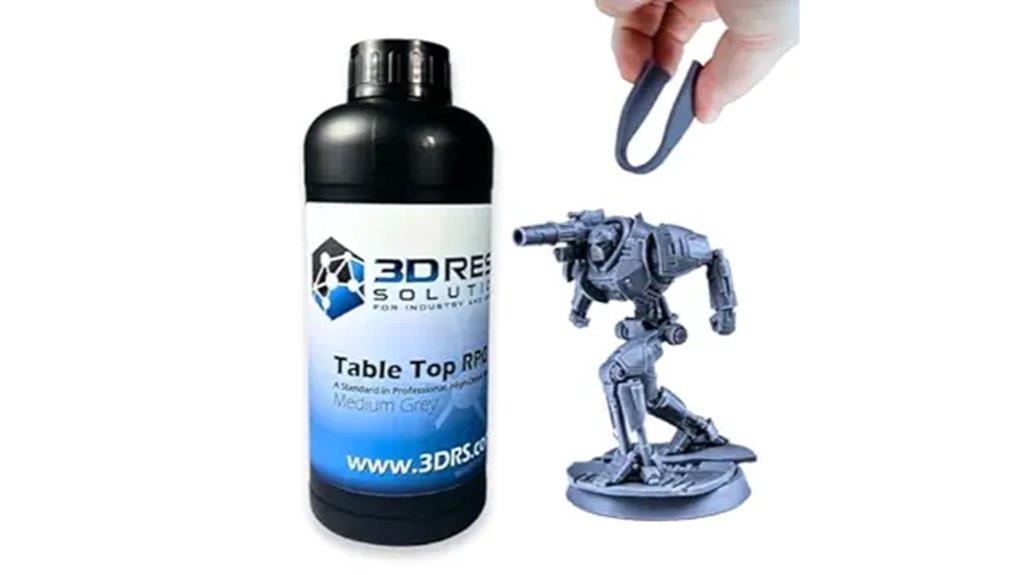
Designed for hobbyists and professional modelers alike, the Table Top RPG 3D Printing Resin by 3DRS delivers high precision and durability, making it ideal for creating detailed miniatures, terrain, and prototypes. It’s compatible with LCD, DLP, and SLA printers, ensuring versatile use across various setups. The resin cures quickly—around 2 to 2.5 seconds per layer—reducing print times and increasing efficiency. Its low odor improves the working environment, while its high green strength minimizes supports and simplifies cleanup. Engineered for impact resistance and fine detail, it produces smooth, sharp surfaces with minimal shrinkage, perfect for high-quality, durable miniatures and models.
Best For: hobbyists, professional modelers, and industrial users seeking high-precision, durable resin for detailed miniatures, terrain, and prototypes.
Pros:
- Rapid curing time of approximately 2–2.5 seconds per layer improves printing efficiency
- High green strength reduces need for supports and simplifies cleanup
- Excellent detail capture with minimal shrinkage and smooth surface finish
Cons:
- May require careful handling due to resin’s impact resistance and toughness
- Needs compatible LCD, DLP, or SLA printers for optimal results
- Slightly higher cost compared to standard beginner resins
Phrozen Aqua-Gray 8K 3D Printing Resin

For anyone aiming to create highly detailed and precise models, Phrozen Aqua-Gray 8K 3D Printing Resin is an excellent choice, especially when paired with 8K LCD printers like the Sonic Mini 8K. Its low shrinkage and high precision guarantee accurate, dimensionally stable prints with minimal warpage. This resin is perfect for intricate parts, complex prototypes, miniatures, and busts. Its low viscosity makes printing and post-processing easier, and fumes are minimal for a safer, more comfortable experience. With a 1kg bottle and professional support, it’s a reliable solution for achieving stunning, finely detailed models in the highest resolution.
Best For: hobbyists and professionals seeking highly detailed, precise 3D printed models with minimal warpage, especially when using 8K LCD printers like the Sonic Mini 8K.
Pros:
- High precision and low shrinkage for accurate, detailed prints
- Compatible with 8K LCD printers, ensuring top-quality results
- Low viscosity simplifies printing and post-processing steps
Cons:
- May require careful handling due to resin fumes, despite being minimal
- Slightly higher cost compared to lower-resolution resins
- Limited color options, primarily suited for gray-toned models
ANYCUBIC 3D Printer Resin, ABS-Like Resin Pro 2
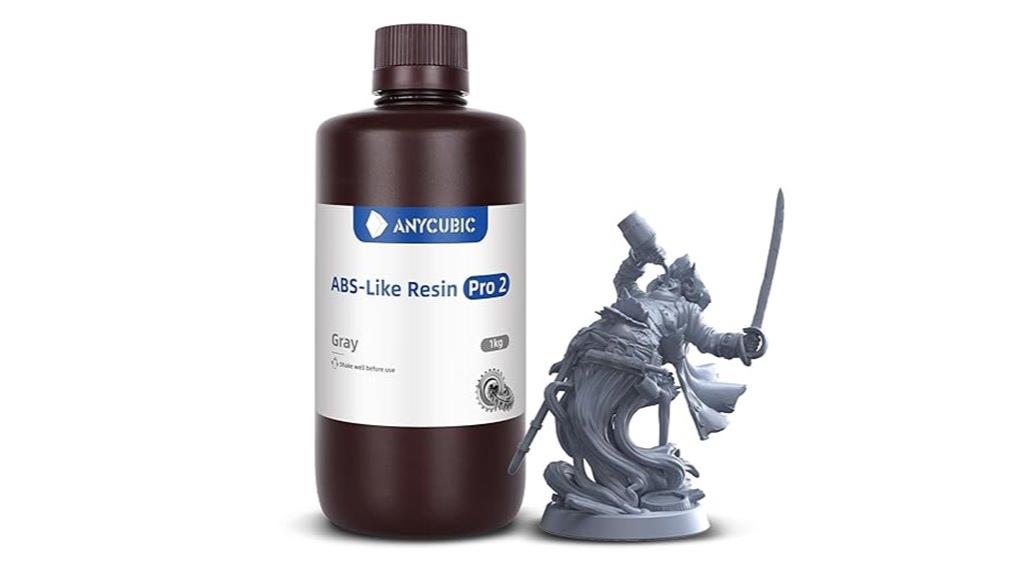
If you’re seeking a resin that combines high strength and durability with precise, detailed prints, ANYCUBIC’s ABS-Like Resin Pro 2 is an excellent choice. It features a 114% increase in elongation at break, making models notably tougher and more resistant to strain. Its high flowability and low viscosity improve curing times and model accuracy, reducing failures and distortion. Compatible with all resin 3D printers, it’s versatile for various applications. Plus, the low-odor formulation creates a more comfortable printing environment. With 1kg per package, Resin Pro 2 offers consistent quality, perfect for demanding projects requiring high strength and fine detail.
Best For: hobbyists, professionals, and industries requiring high-strength, detailed 3D printed models with durability and precision.
Pros:
- Significantly increased strength and toughness with 114% higher elongation at break for durable, strain-resistant models
- High flowability and low viscosity minimize curing time, reduce failures, and enhance model accuracy
- Compatible with all resin 3D printers and features low-odor formulation for a comfortable printing environment
Cons:
- May be slightly more expensive than standard resins due to enhanced properties
- Requires careful handling to avoid overexposure to fumes, despite low-odor formulation
- Longer curing times could be needed for certain complex or large models
ANYCUBIC Upgraded Standard 3D Printer Resin (White, 1000g)
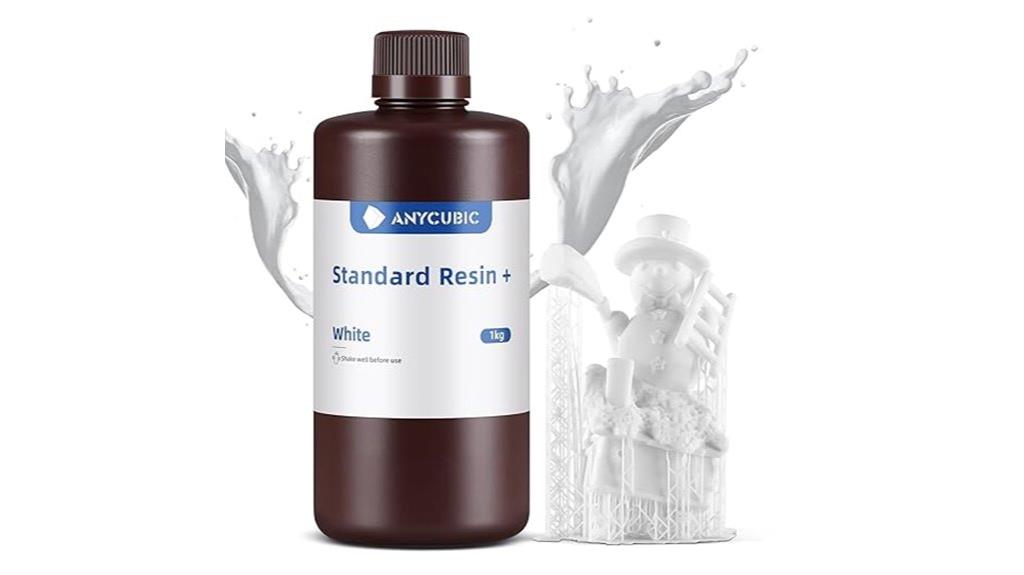
Looking to achieve highly detailed and durable 3D prints quickly? I recommend the ANYCUBIC Upgraded Standard Resin (White, 1000g). This 405nm UV-curing resin is optimized for high-precision, fast printing with 8K-capable LCD, DLP, and SLA printers. Its improved formula reduces shrinkage and increases accuracy from ±0.2mm to ±0.1mm, capturing intricate details. The resin flows smoothly at 200 cps, shortening print times and maximizing resin use. It balances toughness with resilience, creating durable, damage-resistant parts. Plus, it emits lighter odor, making indoor printing more comfortable, with an extended shelf life of 18 months.
Best For: hobbyists and professionals seeking high-precision, durable, and fast-curing resin for detailed 3D prints on LCD, DLP, or SLA printers.
Pros:
- High accuracy with ±0.1mm detail, perfect for intricate designs
- Smooth flowing viscosity at 200 cps reduces print time and resin waste
- Extended shelf life of 18 months and lighter odor for comfortable indoor use
Cons:
- Requires thorough shaking before use to ensure even mixing
- Compatibility may depend on specific printer models, despite broad claims
- Handling and post-processing still involve some safety precautions due to resin toxicity
ANYCUBIC ABS-Like Resin Pro 2 3D Printer Resin (Grey+Grey, 2kg)
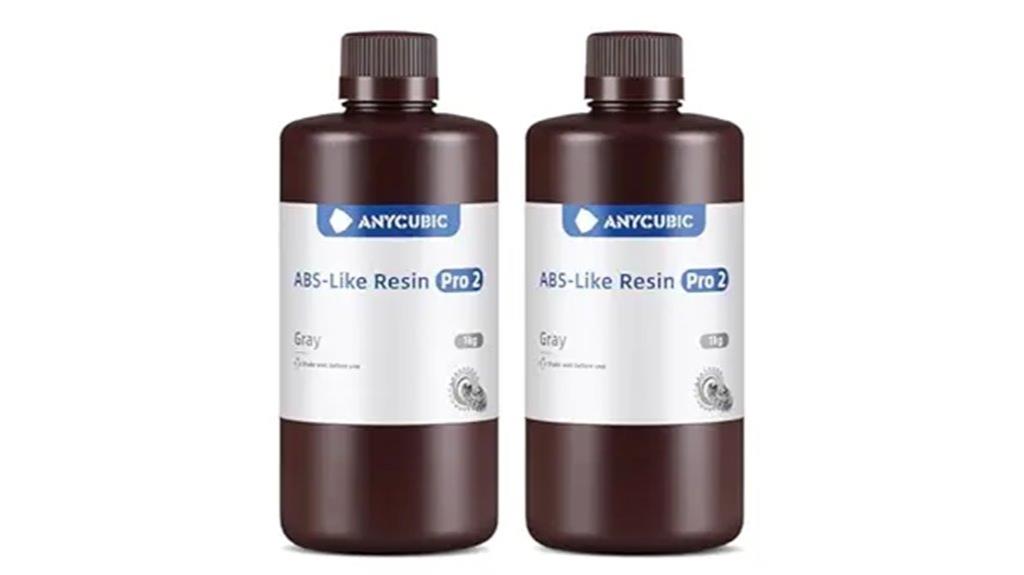
The ANYCUBIC ABS-Like Resin Pro 2 is an excellent choice for users seeking high-strength, durable prints with fine detail. It boosts toughness and elongation by over 100%, making models resilient enough for structural or functional parts. The resin captures sharp 8K detail with smooth surfaces and minimal warping, while offering excellent dimensional accuracy. Its low viscosity and rapid curing ensure reliable, high-quality prints with fewer failures. Compatible with a wide range of LCD and DLP printers, it adheres well to the build plate. Post-processing is straightforward, and parts can be easily sanded and painted. Priced affordably, it’s ideal for both hobbyists and professionals prioritizing durability and precision.
Best For: hobbyists and professionals seeking high-strength, detailed, and durable 3D prints with excellent surface quality at an affordable price.
Pros:
- Enhances toughness and elongation by over 100%, suitable for structural and functional parts
- Produces sharp 8K detail with smooth, high-quality surface finishes
- Easy to post-process, sanding, and painting, with reliable adhesion and minimal warping
Cons:
- Slightly longer layer exposure times compared to some other resins
- Requires careful handling to avoid staining during cleaning with IPA
- Not the fastest resin on the market, which may affect high-volume printing efficiency
3D Printing Resin, Matte Finish 8K Photopolymer Resin for High-Precision 3D Printers

For professionals and artists demanding exceptional detail, resin 3D printers equipped with matte finish 8K photopolymer resin deliver unparalleled resolution and surface quality. FUNCRECOL’s 8K resin offers high-precision results with a smooth, low-gloss surface that minimizes light reflection, enhancing realism. Its balanced viscosity guarantees a high success rate, reducing failures and capturing intricate details sharply. Easy to handle and clean, it suits a range of applications from artistic models to mold-making. This resin’s ability to produce clear, sharp, and detailed prints makes it ideal for those seeking professional-grade, high-resolution results in their 3D printing workflow.
Best For: professionals, artists, and mold makers seeking high-resolution, detailed 3D prints with a smooth, matte finish.
Pros:
- Produces high-precision, detailed models with sharp resolution.
- Smooth, low-gloss surface minimizes light reflection for realistic finishes.
- Easy to handle and clean with versatile cleaning options, reducing print failures.
Cons:
- Requires careful handling and proper curing to achieve optimal results.
- May have a higher cost compared to standard resins.
- Limited color options, primarily available in skin tone and similar shades.
ANYCUBIC Water Washable Resin 2.0 for 3D Printing
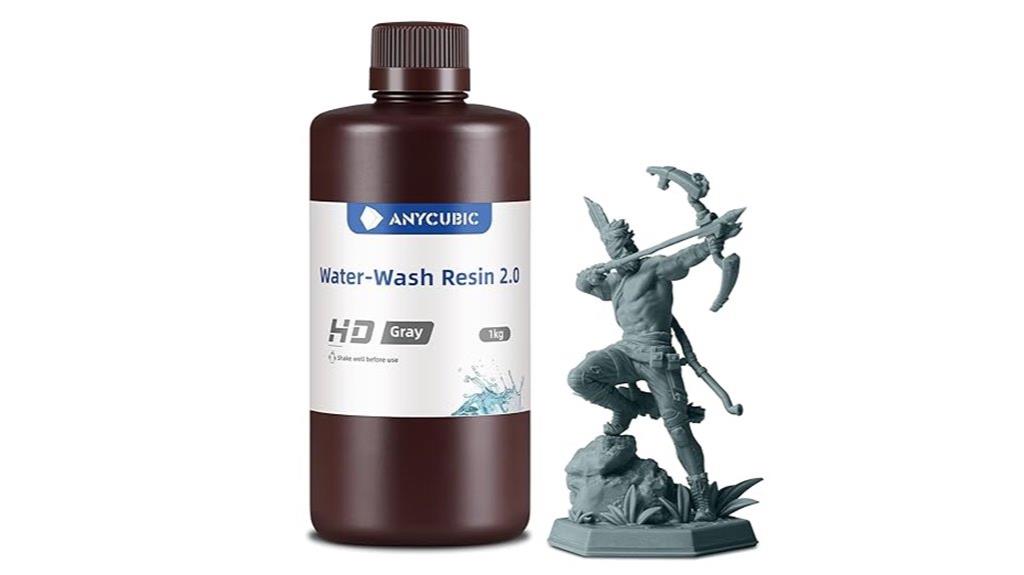
Are you searching for a resin that simplifies post-processing and delivers high-precision models? The ANYCUBIC Water Washable Resin 2.0 makes cleaning easy by using water instead of alcohol, saving time and costs. It offers excellent detail with minimal shrinkage, resulting in smooth, precise surfaces, and its upgraded formula reduces cracking for durable, reliable parts. Compatible with a wide range of LCD and DLP printers, especially ANYCUBIC models, it’s perfect for industrial, prototype, and DIY projects. Plus, you can clean it with water, ultrasonic baths, or Wash & Cure Machines, making the entire process more efficient and eco-friendly.
Best For: hobbyists, industrial manufacturers, and DIY enthusiasts seeking high-precision, water-washable 3D printing resin for detailed and durable models.
Pros:
- Easy water-based cleaning reduces costs and eliminates alcohol use.
- High precision with minimal shrinkage ensures smooth, detailed surfaces.
- Upgraded formula minimizes cracking, enhancing model durability and longevity.
Cons:
- Limited to 8K capable LCD DLP printers; compatibility may vary with older models.
- Requires thorough shaking before use to ensure proper mixing.
- Shelf life of approximately 1.5 years may necessitate timely usage to avoid waste.
Dual-Placement Resin 3D Printer Enclosure Cover with Ventilation Fan

If you’re looking to enhance safety and airflow during resin 3D printing, the Dual-Placement Resin 3D Printer Enclosure Cover with Ventilation Fan offers a versatile solution. Its design allows for horizontal or vertical positioning, fitting various printers, including resin, laser engravers, and some FDM models. Made from durable, multi-layer composite materials, it’s waterproof, fireproof, and built for safety. The enclosure includes a powerful 12V fan with adjustable speed, along with a three-layer filtration system that absorbs dust, fumes, and UV rays. Compact yet effective, this enclosure helps maintain a cleaner, safer environment while protecting your eyes and workspace.
Best For: hobbyists, professionals, and makers seeking a safe, well-ventilated enclosure for resin or laser 3D printing to improve safety and environmental protection.
Pros:
- Durable five-layer composite construction provides waterproof and fireproof safety.
- Adjustable ventilation fan with three-layer filtration effectively removes fumes, dust, and UV rays.
- Versatile dual placement options (horizontal or vertical) accommodate various printer sizes and setups.
Cons:
- Dimensions and fit depend on specific printer sizes; may require measurement before purchasing.
- Assembly is required, which could be time-consuming for some users.
- Not including the printer or tools, so additional purchases may be necessary for complete setup.
ELEGOO ABS-Like Resin 3.0+ for 3D Printing (2000g)
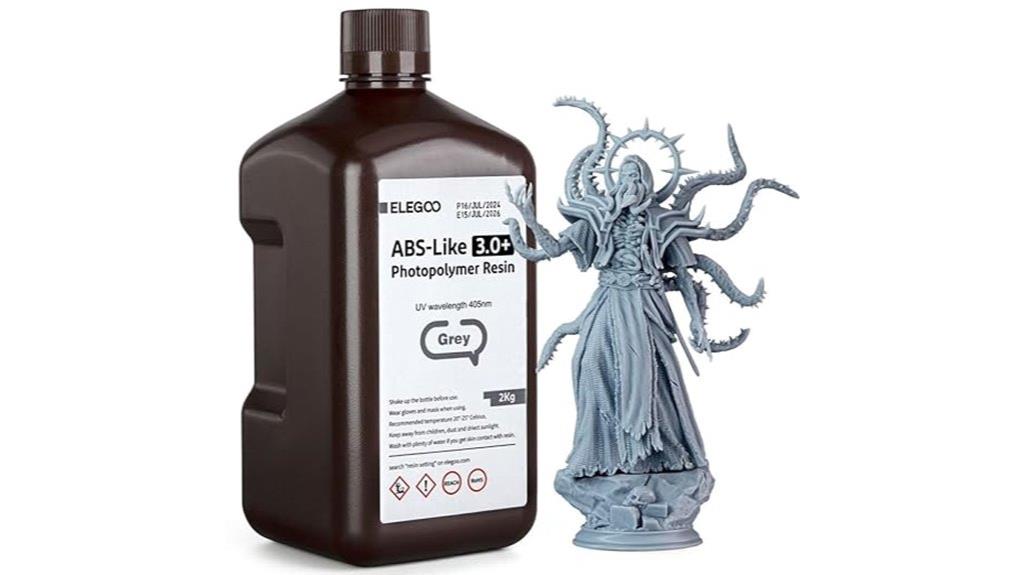
Looking to create durable, high-precision models with your LCD or DLP 3D printer? ELEGOO ABS-Like Resin 3.0+ is an upgraded photopolymer designed for ideal compatibility with 405nm UV light printers, including ELEGOO models. It offers excellent heat resistance up to 55°C and high impact strength, making your prints tough and flexible. The resin produces smooth surfaces with fine detail, thanks to low shrinkage rates. Its fast curing times boost efficiency without sacrificing accuracy. Perfect for prototypes, functional parts, or detailed models, ELEGOO ABS-Like Resin 3.0+ helps you streamline your printing process while ensuring durable, high-quality results.
Best For: hobbyists and professionals seeking durable, high-precision, and heat-resistant 3D printed models using LCD or DLP printers.
Pros:
- High heat resistance up to 55°C, reducing deformation risks
- Excellent impact strength, making models tough and flexible
- Smooth surface finish with fine detail preservation due to low shrinkage
Cons:
- Requires proper handling and curing to avoid issues like incomplete setting
- May produce fumes during printing and curing, necessitating good ventilation
- Slightly higher material cost compared to standard resins
Factors to Consider When Choosing Resin 3D Printers for Precision Parts
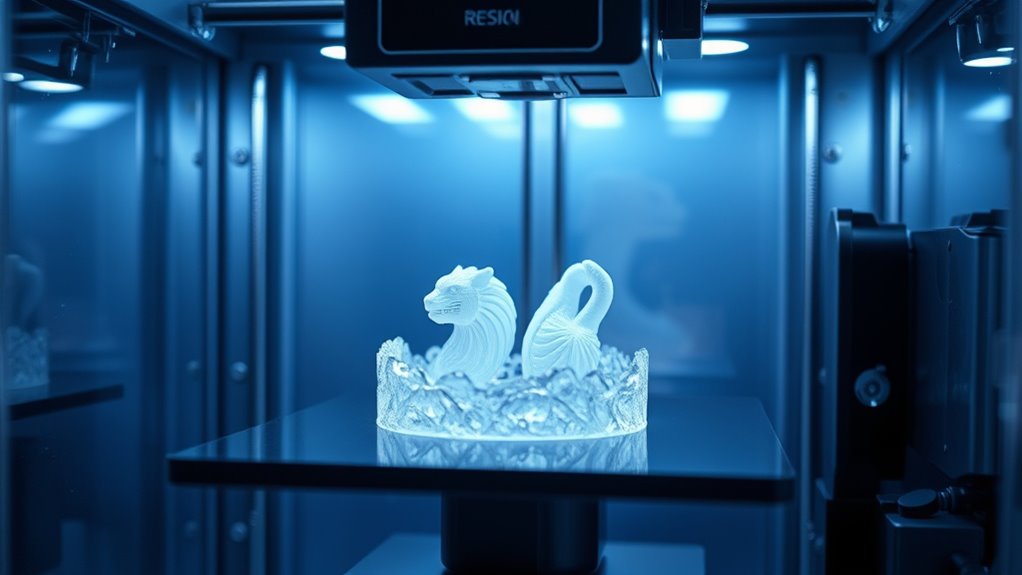
When selecting a resin 3D printer for precision parts, I focus on factors like resolution and detail level to guarantee accuracy. I also consider resin compatibility, print size limitations, and post-processing needs to match my project requirements. Ultimately, I look at printer speed and efficiency to balance quality with production time.
Resolution and Detail Level
Choosing a resin 3D printer for precision parts hinges considerably on its resolution and ability to produce fine details. Higher-resolution printers, such as those with 8K LCD screens, deliver sharper features and intricate textures. The layer height, measured in micrometers, directly impacts detail; smaller layers yield smoother surfaces and finer details. Resins formulated for high detail, with low shrinkage and excellent dimensional stability, further improve accuracy. The optical resolution of the LCD, DLP, or SLA light source determines the maximum possible detail, with higher pixel densities enabling finer textures. Achieving top-tier resolution requires a combination of precise hardware, suitable resin formulations, and optimized exposure settings. These factors collectively ensure the finished parts exhibit the exceptional detail and clarity essential for precision applications.
Resin Compatibility and Types
Selecting the right resin for your 3D printer is essential to achieving high-precision parts, as different resins are formulated for specific wavelengths like 405nm or 385-405nm UV light. Compatibility is key because using the wrong resin can lead to poor adhesion or print failures. Resin types vary widely, including standard, ABS-like, high-detail, and flexible options, each offering different mechanical properties suited for specific applications. Viscosity also matters; lower viscosity resins flow better, print faster, and produce finer details. Additionally, some resins are water-washable or eco-friendly, simplifying post-processing and reducing safety concerns. Ultimately, your resin choice should align with your desired surface finish, detail level, and mechanical strength, ensuring optimal results for your precision parts.
Print Size Limitations
The build size of a resin 3D printer directly influences the maximum dimensions of parts you can produce, which is vital for guaranteeing your designs fit within the printer’s capabilities. Larger print volumes allow for bigger models, but they also come with trade-offs like increased print time and higher resin consumption, impacting cost and efficiency. The XY and Z axis limits determine the maximum size for detailed parts, so measuring your designs to match these boundaries is essential. For highly detailed work, guarantee the printer’s resolution supports your desired size without sacrificing surface quality or detail accuracy. Keep in mind that printing larger parts can also increase the risk of warping or layer separation, especially depending on resin properties and print settings.
Post-Processing Requirements
Post-processing plays an essential role in achieving the highest quality and accuracy in resin 3D printed parts, especially when precision is critical. Proper cleaning with alcohol, water, or ultrasonic solutions removes uncured resin, ensuring a clean surface. Curing times and methods like UV or sunlight exposure are vital for final strength, detail, and surface finish. Surface smoothing techniques such as sanding, polishing, or coatings can further enhance appearance and functionality, especially for detailed parts. Some resins demand specific post-curing environments, like dedicated stations with controlled UV light and temperature. Paying close attention to these requirements helps maintain dimensional accuracy and surface quality, which are crucial for engineering or medical applications. Proper post-processing is as important as the printing itself in achieving precision.
Printer Speed and Efficiency
Choosing a resin 3D printer that balances speed and precision can considerably impact your workflow and output quality. Faster curing times, typically between 1.5 to 3 seconds per layer, boost efficiency and cut down production time. High flowability, low viscosity resins enable quicker layer formation and reduce failures, saving post-processing effort. High-resolution printers with optimized exposure settings can accelerate printing without sacrificing detail. Adjusting layer height and exposure time influences speed; lowering layer height improves detail but may extend the process. Many efficient printers also feature automatic calibration and support systems that simplify setup and minimize manual adjustments. Overall, selecting a printer with these capabilities guarantees you maximize productivity while maintaining the precision necessary for detailed parts.
Material Strength and Flexibility
When selecting a resin 3D printer for precision parts, considering material strength and flexibility is essential. Material strength, measured by tensile strength, impact resistance, and elongation at break, determines how durable your final parts will be. High-strength resins offer low shrinkage and high dimensional stability, ensuring parts stay precise and free from warping. Flexibility is equally important; resins with over 35% elongation at break can absorb shocks and bend without cracking, making them ideal for functional prototypes. However, balancing strength and flexibility is key—resins that are too brittle may fracture easily, while overly flexible options might lack rigidity. Choosing the right resin depends on your specific application’s need for durability, resilience, and precision.
Safety and Environmental Factors
Safety and environmental considerations play a vital role in selecting resin 3D printers for producing precision parts. I always look for resins with low fumes and minimal odor to keep indoor environments safe and comfortable. Choosing low VOC resins helps reduce health risks and minimizes environmental impact. Water-washable or eco-friendly resins simplify cleanup, lowering chemical waste and exposure. I also verify that the printer has effective ventilation systems, such as multi-layer filter fans, to safely disperse fumes and airborne particles. Additionally, I prefer resins formulated with safety features like reduced shrinkage and cracking, which prevent hazardous failures and guarantee stable, safe prints. Prioritizing these factors guarantees a safer working environment and aligns with sustainable practices.
Cost and Accessibility
The cost and accessibility of resin 3D printers substantially influence which models are suitable for producing precision parts. Professional-grade models can cost several thousand dollars, but entry-level options are available for a few hundred dollars. High-quality resins, such as those with high detail capture and low shrinkage, add to overall costs but are essential for precision results. Compatibility with various resin types, including water-washable and specialty resins, also affects affordability and ease of use. Accessibility depends on the availability of replacement parts, consumables, and technical support, which are crucial for maintaining accuracy over time. Additionally, open-source or less proprietary systems improve accessibility by offering more affordable options and simpler upgrade paths, making precise resin printing more attainable for a broader audience.
Frequently Asked Questions
How Does Resin Type Affect Print Detail and Surface Finish?
The resin type directly impacts print detail and surface finish by influencing curing properties and clarity. I find that high-quality, clear resins produce smoother surfaces with finer details, while more viscous or pigmented resins may leave textured finishes. Choosing the right resin guarantees sharper features and a professional look. I always test different types to see which offers the best balance of detail, strength, and surface quality for my projects.
What Are the Maintenance Requirements for High-Precision Resin 3D Printers?
Think of maintaining a high-precision resin 3D printer as tending a delicate garden. I regularly clean the resin vat and build platform to prevent residue buildup, check and replace UV filters, and keep the firmware updated. Calibration is key, so I routinely verify the print bed level and resin flow. Proper storage of resin and routine cleaning help make certain of consistent accuracy, much like caring for a finely tuned instrument.
Can Resin 3D Printers Print Multi-Material or Multi-Color Parts?
Yes, resin 3D printers can print multi-material or multi-color parts, but it depends on the specific model. Some advanced printers have multiple resin tanks or color mixing capabilities, allowing for complex, multi-color prints. Others use color filters or post-processing techniques to attain multi-color results. I recommend checking the printer’s specifications to guarantee it supports multi-material or multi-color printing before making a purchase.
What Safety Precautions Are Necessary During Resin Printing and Post-Processing?
During resin printing and post-processing, I always wear gloves and safety goggles to protect my skin and eyes from harmful chemicals. I work in a well-ventilated space to avoid inhaling fumes, and I handle the resin carefully, avoiding spills. After printing, I clean parts with isopropyl alcohol and dispose of waste properly. These precautions keep me safe while achieving high-quality results.
How Do Environmental Factors Impact Resin Curing and Print Quality?
I’ve found that environmental factors really do impact resin curing and print quality. Humidity can cause clouding or incomplete curing, while temperature fluctuations slow down or disrupt the process. I always keep my workspace stable and avoid drafts or direct sunlight. It’s surprising how even small changes can affect the final detail and strength of the print. Staying mindful of these conditions helps me achieve consistently precise results.
Conclusion
Choosing the right resin 3D printer can truly transform your precision parts. Did you know that resin printers offer up to 25 microns of detail, making even the tiniest features stand out? With options like high-resolution resins and accessories designed for accuracy, I’ve found that investing in quality pays off. Whether for miniatures or detailed prototypes, the right setup guarantees unmatched detail and reliability—boosting your creative projects to new heights.
